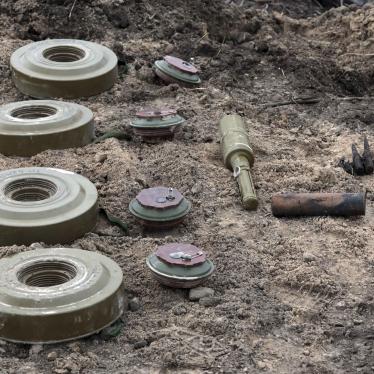Thanks to the Mine Ban Treaty’s implementation support unit, the European Union, and government of Cambodia for convening today’s seminar.
I will begin with a simple proposition: the number of antipersonnel mines absolutely necessary for research and training is ZERO. Zero.
This is the view of the International Campaign to Ban Landmines including Human Rights Watch, as well as a majority of states parties, including some former stockpilers.
During the 1997 negotiations of the Mine Ban Treaty, nations hotly debated whether to allow an exception to the strict requirement that all states parties destroy their stockpiled antipersonnel mines. The strong differences of opinion resulted in an exception under Article 3 to allow states parties to retain antipersonnel mines for research and training purposes, while rigorous reporting requirements were also mandated. These safeguards have gotten stronger with subsequent Action Plans agreed to by States Parties at the Mine Ban Treaty’s review conferences and meetings.
There were and still are many reasons for opposing the retention of live antipersonnel mines. Indeed, the justifications for retaining have only grown weaker and more unnecessary over time.
The opposition arguments against retaining live mines for training can be summed up in three bundles: the clear negatives of retaining; the potential negatives of retaining; and the lack of a demonstrated need to retain.
Regarding the negatives, perhaps the greatest is that retention undermines the norm of the ban on and eradication of all antipersonnel mines. It makes stigmatization of antipersonnel mines many times more difficult. It is hard to explain the exception to the general public and media. It makes no sense to many people who, no surprise, have trouble understanding why a comprehensive ban treaty has more than 60 states parties that collectively retain more than 120,000 antipersonnel mines.
Regarding potential negatives—it is clearly a potential loophole in the ban treaty. Numerous states parties have chosen to retain so many antipersonnel mines that they are operationally significant and could end up being used. There is also the danger that retained mines could be stolen, captured or otherwise acquired.
Regarding the lack of a need for retaining antipersonnel mines, many states parties that retain antipersonnel mines do not report consuming any of them, year after year. A few have never reported any utilization of “retained” mines. It would appear that these are in fact stockpiled mines, and thus a violation of the Mine Ban Treaty.
Unfortunately, there have been many gaps in Article 3 reporting, and a great deal of information that does not get reported. This negates the safeguard nature of the legally-binding reporting requirements.
There have been technical developments over the past 25 years that make it unnecessary to retain live mines for detection and training purposes. In any event, any perceived benefit of live mines is not significant enough to justify the exception to the prohibition on stockpiling.
I look forward to the discussions.







